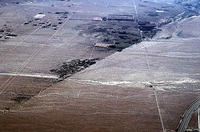-
New facility for hurricane research to study why some storms intensify so quickly
It still astonishes meteorologists. In the span of just twenty-four hours, Hurricane Wilma, the twenty-second named storm of the record-breaking 2005 Atlantic hurricane season, intensified from a tropical cyclone to a Category 5 hurricane — its wind speed soaring from 70 to 175 mph. As remarkable as Wilma’s rapid intensification was, however, it is not the only case of a storm muscling up at warp speed. As Hurricane Charley approached Florida’s west coast in 2004, its sustained winds jumped from 110 to 150 mph in only three hours. In 2007 Felix strengthened from a meager tropical depression to a Category 5 hurricane in fifty-one hours. This could all change soon now that the University of Miami’s Rosenstiel School of Marine and Atmospheric Science has opened its Marine Technology and Life Sciences Seawater Complex, a $50 million facility that houses a 38,000-gallon, 75-foot-long tank into which researchers pump seawater to study how the ocean and atmosphere interact — the critical air-sea interface that could tell us why some storms intensify so quickly.
-
-
Floating cities increasingly attractive prospect in the face of sea level rise, floods

More and more urban planners and disaster managers are asking the question: “Has the time come for floating cities?” Experts say thatin the face of climate change-driven sea level rise and shifting weather patterns poised seriously to impact many cities over the course of the next decades, the option of having cities that can accommodate shifting tides is making more and more sense.
-
-
Hydraulic fracturing caused earthquakes in Ohio
Hydraulic fracturing triggered a series of small earthquakes in 2013 on a previously unmapped fault in Harrison County, Ohio, according to a new study. This series of earthquakes is the first known instance of seismicity in the area. Hydraulic fracturing, or fracking, is a method for extracting gas and oil from shale rock by injecting a high-pressure water mixture directed at the rock to release the gas inside. The process of hydraulic fracturing involves injecting water, sand and chemicals into the rock under high pressure to create cracks. The process of cracking rocks results in micro- earthquakes.
-
-
Sections of the San Andreas Fault system in San Francisco Bay Area are locked, overdue

The earthquake cycle reflects the accumulation of strain on a fault, its release as slip, and its re-accumulation and re-release. Fault creep is the slip and slow release of strain in the uppermost part of the Earth’s crust that occurs on some faults between large earthquakes, when much greater stress is released in only seconds. Where no fault creep occurs, a fault is considered locked and stress will build until it is released by an earthquake. Four urban sections of the San Andreas Fault system in Northern California have stored enough energy to produce major earthquakes, according to a new study that measures fault creep. Three fault sections — Hayward, Rodgers Creek, and Green Valley — are nearing or past their average recurrence interval, according to the study.
-
-
In worst-case scenario, sea level would rise 1.8 meters
The climate is getting warmer, the ice sheets are melting and sea levels are rising — but how much? The report of the UN’s Intergovernmental Panel on Climate Change (IPCC) in 2013 was based on the best available estimates of future sea levels, but the panel was not able to come up with an upper limit for sea level rise within this century. Now researchers have calculated the risk for a worst-case scenario. The results indicate that at worst, the sea level would rise a maximum of 1.8 meters – but the much more likely rise in sea level would be around 80 cm.
-
-
Bay Area’s infrastructure more resilient, but a major tremor would paralyze region’s economy
Twenty-five years ago, the San Francisco Bay Area suffered the 6.9 magnitude Loma Prieta earthquake, which killed sixty-three people, injured 3,700, destroyed 366 businesses and 11,000 homes, and caused $6 billion in property damage. Since then, bridges and roads have been rebuilt to withstand more powerful quakes, but seismic safety experts say more could be done to protect property and human life. A major earthquake is not likely completely to destroy the Golden Gate Bridge or other major infrastructure developments, but the Bay Area’s $535 billion a year economy will come to a halt for months and even years due to weakened critical infrastructure.
-
-
U.S. military must be ready for climate change: Hagel
Climate change is a threat multiplier, and the U.S. Defense Department is taking steps to incorporate this issue into all planning, Defense Secretary Chuck Hagel said in Peru Monday. Climate change has the potential to exacerbate many of the challenges the world already confronts, from the spread of infectious diseases to spurring armed conflicts, Hagel said at the Conference of the Defense Ministers of the Americas. Hagel announced a Defense Department Climate Change Adaptation Roadmap during his speech. The roadmap is based on science, he said, and describes the effects of climate change on DoD’s missions and responsibilities.
-
-
15 years from now, our impact on regional sea level will be clear

Coastal communities and industries require information on regional sea-level change to develop strategies for reducing the risk to population, infrastructure and the environment. This requires modeling projections of sea-level rise, estimating the costs and benefits of adaptation options, and understanding the impacts on coastal ecosystems. Inundation maps that can be used to identify areas that are most vulnerable to rising sea levels are particularly valuable. Adaptation measures may include land-use planning such as preventing building in low lying areas, increasing or maintaining a vegetated coastal margin that serves as a buffer zone against extreme sea levels, or using protective sea walls in the long run if certain sea level rise thresholds are exceeded.
-
-
U.S. should emulate allies in pushing for public-private cybersecurity collaboration
Israeli Prime Minister Benjamin Netanyahu announced last month the formation of a national cyber defense authority to defend civilian networks under the leadership of the Israel National Cyber Bureau.The “U.S. government has a lot to learn from successful examples in allied nations. With more compromise and reform, there is plenty of reason for hope,” says a cybersecurity expert, adding that “a cybersecurity partnership between government, business, and individuals built on trust is possible, and would promote more resilient networks as well as creative thinking on cybersecurity.”
-
-
Some states are better prepared than others for climate change challenges
In recent years, a number of states have started taking action to prepare their communities for climate change. Many have even developed specific adaptation plans to guide their work. Until now, though, no one has been able to define how much progress states are actually making in implementing those plans. The Georgetown Climate Center’s (GCC) online tool, the State Adaptation Progress Tracker, changes that. A GCC release says that now, anyone will be able to quickly determine how much progress their state is making and decision-makers will be able to learn from innovative examples of actions other states are taking.
-
-
The likelihood of a California Big One “uncomfortably high”: Experts

Research on the San Andreas fault has shown that the average time between surface-rupturing earthquakes is about a century. Experts say that these findings are a call to action. The last two “big ones” on the San Andreas fault — in 1906 in Northern California and 1857 in Southern California — occurred more than a century ago. There are several ways to calculate the probability of a similar earthquake, but they all give uncomfortably high results. A large earthquake is likely in our lifetime. A magnitude 7.8 earthquake is realistic, one expert says. “Our data show that similar earthquakes happened here in the not-too-distant past. As Shakespeare said, past is prologue. However, past large earthquakes on the San Andreas fault affected very few people. Now millions are at risk.”
-
-
Federally funded cybersecurity center launched
The National Institute of Standards and Technology’s (NIST) National Cybersecurity Center of Excellence(NCCoE) initiative has awarded the first federally funded research and development center (FFRDC) contract for cybersecurity to MITRE Corp., a nonprofit established to operate FFRDCs. Cybersecurity professionals will work with stakeholders in government, the private sector, and academia to develop low cost and scalable cybersecurity solutions.
-
-
As sea level rises, coastal communities brace for more frequent, destructive tidal flooding
Today, many coastal communities are seeing more frequent flooding during high tides. As sea level rises higher over the next fifteen to thirty years, tidal flooding is expected to occur more often, cause more disruption, and even render some areas unusable — all within the time frame of a typical home mortgage. An analysis of fifty-two tide gauges in communities stretching from Portland, Maine to Freeport, Texas shows that most of these communities will experience a steep increase in the number and severity of tidal flooding events over the coming decades, with significant implications for property, infrastructure, and daily life in affected areas. The report warns that given the substantial and nearly ubiquitous rise in the frequency of floods at these fifty-two locations, many other communities along the East and Gulf Coasts will need to brace for similar changes.
-
-
California needs $54 million to deploy ShakeAlert earthquake warning system
Officials in California need $54 million fully to implement the ShakeAlert earthquake warning system, according to a scientist with the U.S. Geological Survey (USGS).ShakeAlert detects earthquakes using the California Integrated Seismic Network of roughly 400 ground motion sensors which identify primary waves (P-waves) as they move through the Earth at almost twice the speed of the earthquakes’ destructive S-waves, which shake the ground.When an earthquake is detected, ShakeAlert informs emergency management officials of the quake’s epicenter, and a computer-generated voice counts the remaining time before shaking occurs.
-
-
Scientist reveals Chelyabinsk meteorite fall’s seismo-ionospheric effects
The meteorite which hit the Russian city of Chelyabinsk on 15 February 2013 was the cause of a large number of dynamic ionospheric, atmospheric, and seismic phenomena. Its explosion created panic among local residents and about 1,500 people were injured seriously enough to seek medical treatment. All of the injuries were due to indirect effects rather than the meteor itself, mainly from broken glass from windows that were blown in when the shock wave arrived, minutes after the superbolide’s flash.
-
- All
- Regional
- Water
- Biometrics
- Borders/Immig
- Business
- Cybersecurity
- Detection
- Disasters
- Government
- Infrastructure
- International
- Public health
- Public Safety
- Communication interoperabillity
- Emergency services
- Emergency medical services
- Fire
- First response
- IEDs
- Law Enforcement
- Law Enforcement Technology
- Military technology
- Nonlethal weapons
- Nuclear weapons
- Personal protection equipment
- Police
- Notification /alert systems
- Situational awareness
- Weapons systems
- Sci-Tech
- Sector Reports
- Surveillance
- Transportation
Advertising & Marketing: advertise@newswirepubs.com
Editorial: editor@newswirepubs.com
General: info@newswirepubs.com
2010-2011 © News Wire Publications, LLC News Wire Publications, LLC
220 Old Country Road | Suite 200 | Mineola | New York | 11501
Permissions and Policies
Editorial: editor@newswirepubs.com
General: info@newswirepubs.com
2010-2011 © News Wire Publications, LLC News Wire Publications, LLC
220 Old Country Road | Suite 200 | Mineola | New York | 11501
Permissions and Policies
